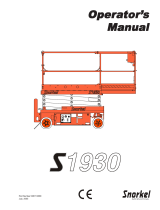
September 2008 Operator's Manual - 2591RT | 3391RT | 4191RT: CE Models
Page 9
♦♦
♦♦
♦ Only authorized, trained and qualified personnel should operate the machine.
♦♦
♦♦
♦ NEVER fasten a fall protection lanyard to an adjacent structure while on the platform.
♦♦
♦♦
♦ Make sure that the platform entry is properly closed and secure before operating the machine from the platform.
♦♦
♦♦
♦ NEVER exceed platform rated capacity. Review the Specifications table (see page 2) regarding model capacities and dimensions.
♦♦
♦♦
♦ Before operating the machine, read and understand all safety and control information found on the machine and in this manual.
♦♦
♦♦
♦ When operating the machine follow all safety and control information found on the machine and in this manual.
♦♦
♦♦
♦ Evenly distribute loads placed on the platform.
♦♦
♦♦
♦ NEVER use scaffolding, ladders or similar items to extend your reach while on the platform.
♦♦
♦♦
♦ NEVER climb down the beam assembly.
♦♦
♦♦
♦ NEVER exit or enter the platform while the platform is elevated.
♦♦
♦♦
♦ Towing or winching the machine requires that the brake be released. When the brake is released, there is no means to stop
the machine’s travel. MEC recommends using this procedure only in cases of emergency, and only for a short distance. Be on
guard against machine runaway on sloping surfaces. Movement speed shall not exceed 5 MPH (8.0 kph).
♦♦
♦♦
♦ NEVER attempt to open any hydraulic line or component without first relieving all system pressure.
♦♦
♦♦
♦ NEVER alter, modify, or disable any safety devices or interlocks.
♦♦
♦♦
♦ NEVER recharge the battery near sparks or open flames. Lead-acid batteries generate EXPLOSIVE HYDROGEN GAS. Always
wear safety glasses.
♦♦
♦♦
♦ NEVER use the machine outdoors during electrical storms or in high wind situations.
♦♦
♦♦
♦ ALWAYS observe the maximum wind speed of 12.5 m/s (28 mph).
♦♦
♦
♦
♦ DO NOT increase the surface area of the platform or the load in windy conditions. Increase of the area exposed to the wind
will decrease stability.
♦♦
♦♦
♦ Only elevate the platform when the machine is on a firm, level surface.
♦♦
♦♦
♦ SECURE all tools and other loose items to prevent injury to persons working on or below the platform.
♦♦
♦♦
♦ Precautions should be taken to prevent unauthorized personnel from operating the platform with the ground controls while the
platform is in use.
♦♦
♦♦
♦ Unassisted loading or unloading of scissorlift from a truck or trailer is not recommended.
♦♦
♦♦
♦ Before disengaging brakes or disconnecting from a tow vehicle, ensure that the machine cannot roll.
♦♦
♦♦
♦ Complete the inspections at designated intervals.
♦♦
♦♦
♦ Use of the machine as a crane to lift oversized or hanging loads is prohibited.
♦♦
♦♦
♦ ALWAYS ensure that the route and areas are clear before driving, lifting or lowering.
♦♦
♦♦
♦ It is recommended to avoid sudden braking or steering. Go slowly and leave more maneuvering room during cold weather operation.
♦♦
♦♦
♦ Only lower the outriggers when the machine is on a firm, level surface. The surface must be capable of supporting the
maximum ground pressure per wheel/outrigger (see specifications).
♦♦
♦♦
♦ DO NOT raise the platform unless all four outriggers are properly lowered and the machine is level.
♦♦
♦♦
♦ DO NOT adjust outriggers while platform is raised.
♦♦
♦♦
♦ DO NOT drive while outriggers are lowered.
























